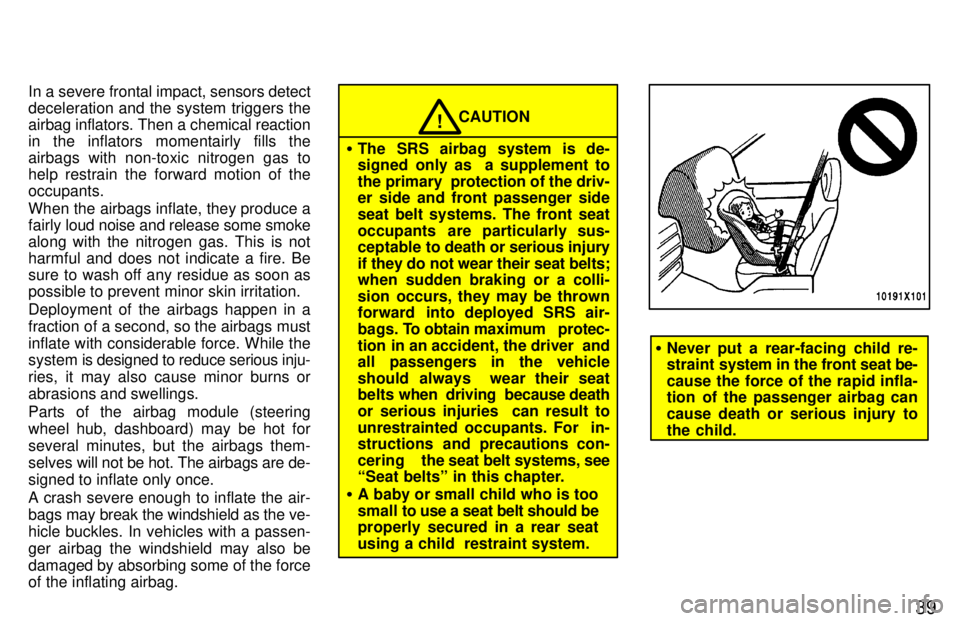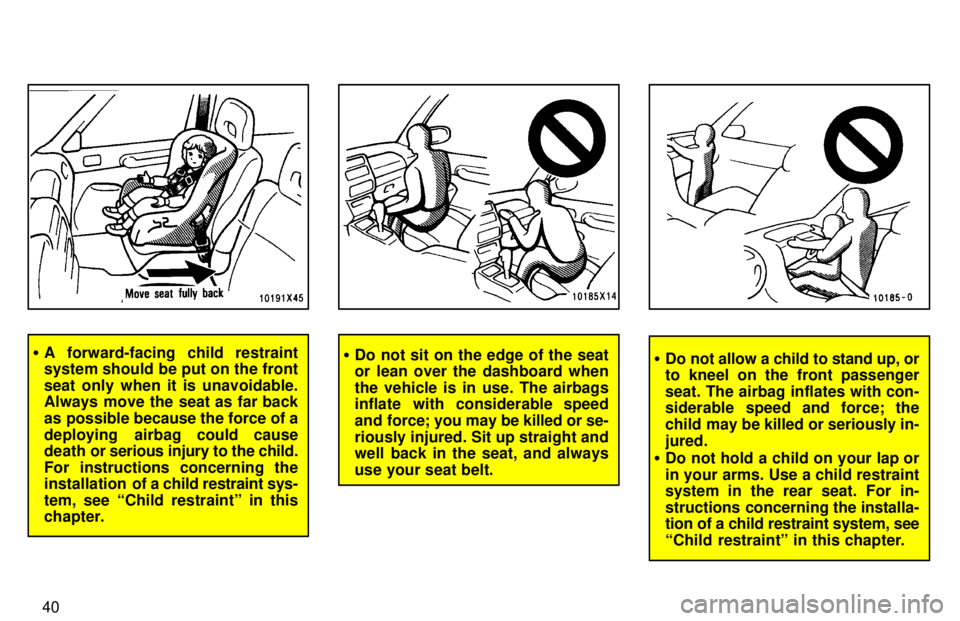Page 38 of 198

37
The SRS (Supplemental Restraint Sys-
tem) airbags are designed to provide
further protection to the driver and
front passenger when added to the pri-
mary protection provided by the seatbelts.
In response to a severe frontal impact, the
SRS airbags work together with the seat
belts to help preventing or reduce injury by
inflating, in order to decrease the likeli-
hood of the driver's or front passenger's
head or chest directly hitting the steering
wheel or dashboard. The passenger air-
bag is activated even with no passenger
in the front seat.This indicator comes on when the
ignition key is turned to the ACCº or
ONº position. It goes off after about 6
seconds. This means the SRS airbags
are operating properly.
The SRS airbag warning light system
monitors the airbag sensor assembly, in-
flators, warning light, interconnecting wir-
ing and power sources.The SRS airbag system is designeed
to activate in response to a severe
frontal impact within the shaded area
between the arrows in the illustration.
The SRS airbags will deploy if the severity
of the impact is above the designed
threshold level, comparable to an approxi-
mate 20 km/h (14 mph) collision when im-
pacting straight into a fixed barrier that
does not move or deform.
If the severity of the impact is below the
above threshold level, the SRS airbags
may not deploy.
SRS airbags
Page 40 of 198

39
In a severe frontal impact, sensors detect
deceleration and the system triggers the
airbag inflators. Then a chemical reaction
in the inflators momentairly fills the
airbags with non-toxic nitrogen gas to
help restrain the forward motion of theoccupants. When the airbags inflate, they produce a fairly
loud noise and release some smoke
along with the nitrogen gas. This is notharmful and does not indicate a fire. Be
sure to wash off any residue as soon as
possible to prevent minor skin irritation.
Deployment of the airbags happen in a
fraction of a second, so the airbags must
inflate with considerable force. While the
system is designed to reduce serious inju-
ries, it may also cause minor burns or
abrasions and swellings.
Parts of the airbag module (steering
wheel hub, dashboard) may be hot forseveral minutes, but the airbags them-selves w ill not be hot. The airbags are de-
signed to inflate only once.
A crash severe enough to inflate the air-
bags may break the windshield as the ve-
hicle buckles. In vehicles with a passen-ger airbag the windshield may also be
damaged by absorbing some of the force
of the inflating airbag.
CAUTION!
� The SRS airbag system is de-
signed only as a supplement to
the primary protection of the driv-
er side and front passenger side seat belt systems. The front seat
occupants are particularly sus-
ceptable to death or serious injury
if they do not wear their seat belts;
when sudden braking or a colli-
sion occurs, they may be thrown
forward into deployed SRS air-
bags. To obtain maximum protec-
tion in an accident, the driver and
all passengers in the vehicle
should always wear their seat
belts when driving because death
or serious injuries can result to
unrestrainted occupants. For in-
structions and precautions con-
cering the seat belt systems, see
Seat beltsº in this chapter.
� A baby or small child who is too
small to use a seat belt should be
properly secured in a rear seat
using a child restraint system.
�Never put a rear-facing child re-
straint system in the front seat be-
cause the force of the rapid infla-
tion of the passenger airbag can cause death or serious injury to
the child.
Page 41 of 198

40
�A forward-facing child restraint
system should be put on the front
seat only when it is unavoidable.
Always move the seat as far back
as possible because the force of a
deploying airbag could cause
death or serious injury to the child.
For instructions concerning the
installation of a child restraint sys-
tem, see Child restraintº in this
chapter.� Do not sit on the edge of the seat
or lean over the dashboard when
the vehicle is in use. The airbags
inflate with considerable speed
and force; you may be killed or se-riously injured. Sit up straight and
well back in the seat, and always
use your seat belt.�Do not allow a child to stand up, or
to kneel on the front passenger
seat. The airbag inflates with con-
siderable speed and force; the
child may be killed or seriously in-jured.
� Do not hold a child on your lap orin your arms. Use a child restraint
system in the rear seat. For in-
structions concerning the installa- tion of a child restraint system, see
Child restraintº in this chapter.
Page 42 of 198

41
�Do not put objects on or in front of
the dashboard or steering wheel
pad that houses the airbag sys-
tem. They might restrict inflation
or cause serious injury as they are
projected rearward by the force of deploying airbags.
�Do not modify or remove any wir-
ing. Do not modify, remove, strike
or open any components, such as
the steering wheel column cover,
front passenger airbag cover, front
passenger airbag, airbag sensor
assembly. Doing any of these may cause sudden SRS airbag inflation or disable the system, which could
result in death or serious injury.
Failure to follow these instructions can result in death or serious inju-ries.
Do not perform any of the following changes without consulting your
Toyota dealer. Such changes can interfere with proper operation ofthe SRS airbag system in some cases.
�Installation of electronic itemssuch as a mobile two-way radio,
cassette tape player or compactdisc player
�Modification of the suspension
system
�Modification of the front endstructure
�Attachment of a grille guard (bullbar, kangaroo bar, etc.), snow-
plow, winches or any other equip-
ment to the front end
�Repairs made on or near the frontend structure, console, steeringcolumn, steering wheel or dash-board near the front passenger
airbag
NOTICE